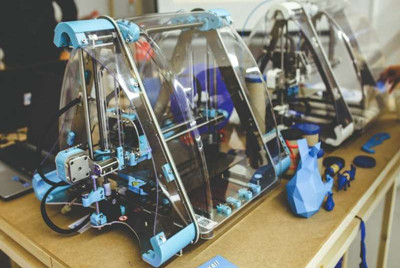
University of Seville researchers, in collaboration with the University of Nottingham, have managed to create the first image of nanoparticles of stabilised gold with biodegradable and biocompatible systems that have been obtained with 3-D-printng techniques. The image chosen for this test was the logo of the University of Seville.
This achievement will have applications in the pharmaceutical industry, such as in the preparation of biocompatible biosensors based on gold, which have already been shown to be effective in the detection of carcinogenic cells and tumour biomarkers. In recent years, additive manufacturing, also commonly known as 3-D printing, has been recognised as the ideal technology for applications that require intricate geometries or personalisation. Its manufacturing based on layers will reduce general small-batch manufacturing costs in comparison with traditional production methods. This has caught the attention of the pharmaceutical industry, which may be a gateway to the total personalisation of treatment with this technology.
The research was centred on the technique called inkjet printing. This technique offers advantages such as high resolution and the possibility it offers to print more than one material during the same printing process. Using this technique, the researchers have proposed the manufacturing of systems that could potentially be used as personalised biosensors based on the conductivity and biocompatibility of gold.
Currently, existing gold inks for inkjet printing are based on nanoparticles of this metal, but they are highly unstable, as they bind together easily and are difficult to print. For that reason, the development of stable gold inks that are easy to print with has been invaluable.
The team was led by Ana Alcudia Cruz, of the Department of Organic and Pharmaceutical Chemistry from the Pharmacy faculty at the University of Seville, in collaboration with the group led by Rafael Prado Gotor of the Department of Physical Chemistry, from the Chemistry Faculty at the University of Seville, and Ricky Wilman, from the University of Nottingham (United Kingdom). For the first time, it managed to use polymers (polyurethanes) with a comb structure, which the team developed, to generate tiny gold nanoparticles with extremely high stability and tested over time.
To that end, various polymers were prepared from arabinose, a sugar that is easily acquired in nature and that gives the material total biocompatibility and biodegradability, thus avoiding polluting residues generated by the traditional polymers that are oil-derived.
For the first time, this type of polymer has been used for the preparation of gold nanoparticles. These nanoparticles, obtained from three different chemically functionalised polymers, proved to be sufficiently small (maximum 10 nm) to be printed by inkjet printing and were stable for a period of at least six months. Once the printability of each ink was tested, that which showed the best balance of properties was selected and used to print the logo of our university. In the image, obtained by TOF-SIMS, the gold can be observed (in yellow), which forms the outline of the logo, on a polymer background (in blue). This is the first image of gold nanoparticles stabilised with biodegradable and biocompatible systems that has been obtained via 3-D-printng techniques.

